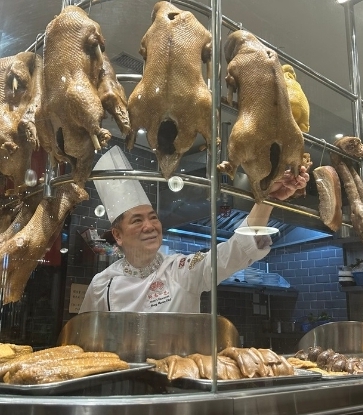Kin’s Kitchen, headed by Lau Chun, is one of the few restaurants in town which offers a rice menu to his patrons. On the night of our visit, diners could choose from the brown rice from Mindanao, the Philippines, Shinmei Yumepirika Rice from Hokkaido, Thai jasmine rice and Yi O rice from Hong Kong. But among all the options, Lau is impartial towards the local product. Not only does he sells it in the restaurant, he also actively participates in the rice’s promotional events. Earlier, he shared some details about the re-production of Yi O rice in a workshop called “Of Rice and Men”.

Yi O on Lantau Island is one of the largest rice production areas in Hong Kong. The variety grown there is a cross-bred long-grain rice developed in Mainland China, chosen for its high quality and yield. The farmers come from different walks of life. Many of them have had experience working in the food industry. Those include Yu Kin Sun, who had worked at esteemed eatery Fook Lam Moon and restaurants in Japan, now the agricultural supervisor at Yi O Farm.
Hong Kong rice is harvested twice a year. The first is planted in February and reaped in June, while the second is sown in July with harvesting taking place in December. Many consumers prefer the second crop, as the rice plant absorbs more nutrients during winter and generates more aromatic grains.

As the rice continues to ripen, the kernels would be filled with rice milk. This adds weight to the top of the plant, leading to it bowing down. At this stage, famers would need to fend off their biggest enemy: birds. Bird nets would be laid on the field to protect the grains. When the rice fully matures, the plant can be cut off from the field using a sickle. And with the aids of some simple machinery, the grains are separated from the plants and removed from the husks. Since the local paddies are smaller and located on a slope, the farms don’t bring in any large-scale machine for assistance. The leftover straws also have uses of their own. A part of them serve as the fertiliser of the field, while the remaining is used as weaving materials and fuel.

The cycle of cultivation of Hong Kong rice takes place over a period of 120 days. Very often during harvest, the rice grains would contain lots of moisture. They have to be dried under the sun for three days before going to storage. The drying process can’t be taken lightly either. The grains need constant turning to ensure all sides are dried evenly. Over-dried rice could crumble easily as it gets milled.
In Yi O, every acre of paddy yields roughly 300 kilograms of rice. The adoption of a natural approach – irrigated with local water, dried under the sun, free from chemical pesticides – leads to its glowing reputation, with its demand outweigh supply in the past few years. The farmers suggest mixing new and old Yi O rice in the ratio of 1:1 to strike a balance in texture and moisture, so it doesn’t taste too soft when cooked.

With quality grains on hand, all it takes is the right technique to make a perfect batch of rice. Lau’s choice of cooking vessel is ceramic pot.
“Ceramic pot does a better job in preserving heat. Even after removed from the heat, the interior would maintain at a high temperature for a long time. That provides an ideal environment for cooking the rice,” he said.
To make a nice bowl of rice, Lau noted the choice of rice is always the most crucial factor. The proportion between rice and water comes second. New rice and old rice have different capacities in absorbing water. New rice, with higher moisture content, should be mixed with old rice to be cooked properly. With the packaged Thai rice in the market, the rice-water ratio is usually 1:1 or 1:1.1.
Lau told us Thai rice needs to be rinsed three times only to remove all the impurities. Overdoing it could eliminate the nutrients in the rice. Let the rice sit in the water for 15 to 20 minutes before cooking, so it begins to absorb the water and becomes fluffier in the end. After the rice is taken off heat, use a rice paddle to fluff the rice, so that every grain picks up an equal amount of steam as it continues to cook. Cover the pot again for 10 minutes. This helps the moisture evaporate and makes for a better texture.
The Perfect Match
When asked about his favourite dish to go with rice, Lau laughed and told us he was content with just rice.
“Among the dishes of my childhood memories, I enjoyed having steamed meat patty, steamed fish and steamed egg custard. Seasoned rice, such as the “oily rice” in Hainan chicken rice, is another favourite of mine. However, I’m less interested in fried rice.”
This article was written by Clarence Chan and translated by Vincent Leung. Click here to read the original version of this story.





















